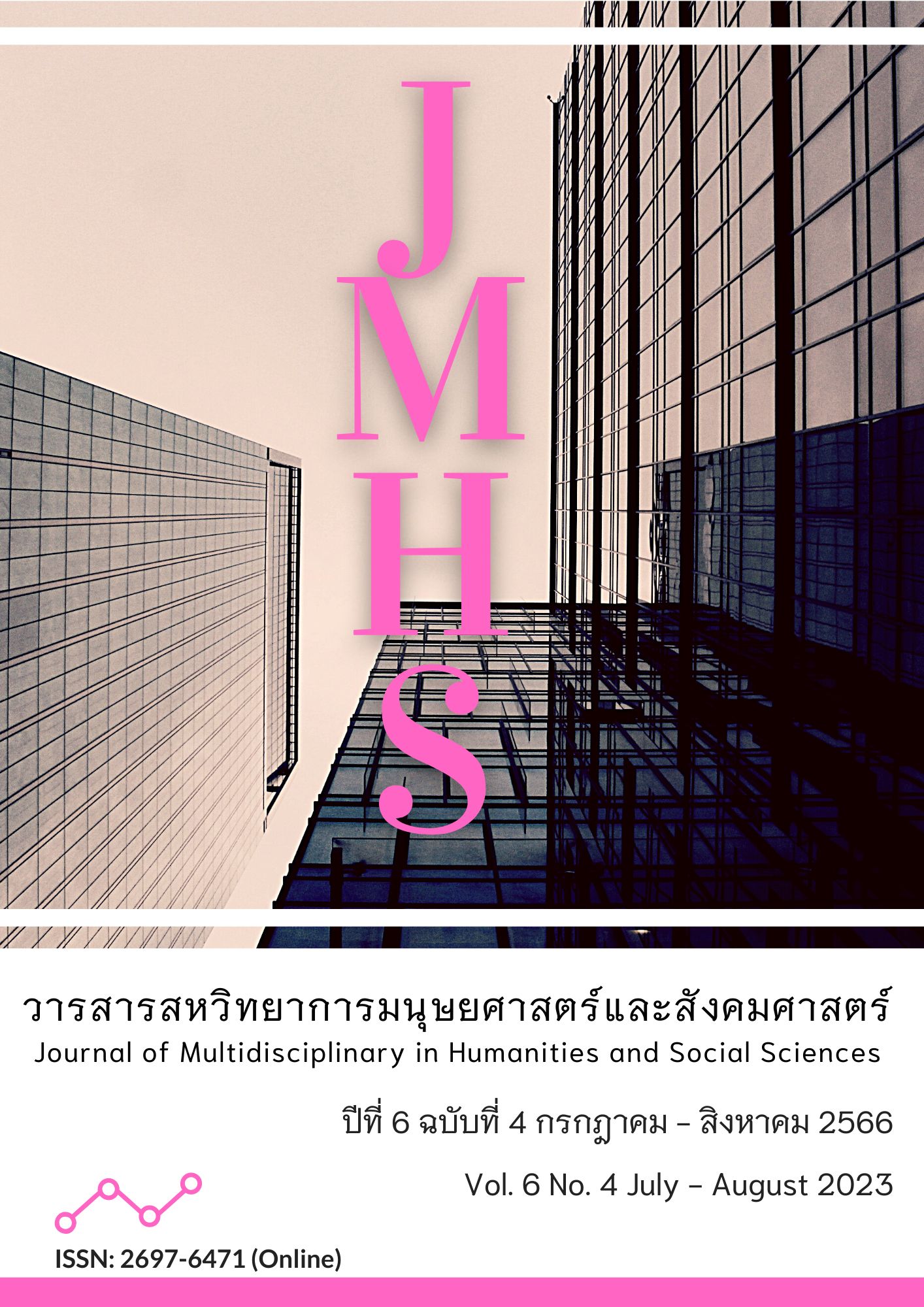Digital Literacy: Needs Assessment and Development Guidelines in The Dimensions of Roles, Emotions, Perceptions, Attitudes and Behaviors of Teachers in Secondary Educational Service Area Offices Bangkok 2
Main Article Content
Abstract
This article aimed to 1) examine the needs assessment for the development of digital literacy among teachers in Secondary Educational Service Area Offices Bangkok 2, and 2) analyze the approaches to developing digital literacy in the dimensions of roles, emotions, perceptions, attitudes, and behaviors of teachers in Secondary Educational Service Area Offices Bangkok 2. The sample group was 450 teachers by the multi-stage random sampling method as follows: 1) Stratified random sampling using the school size according to the OBEC criteria was a random unit; 2) Cluster random sampling schools were randomly derived from size in step 1 because schools within one size were similar. Therefore, random samples were taken from medium-sized schools. large school and large schools; and 3) Stratified random sampling by using the subject group as a unit for random sampling, then selecting a sample from the subject area by simple random sampling. The research instrument was a questionnaire on the assessment of the needs for digital literacy and a semi-structured interview. The data were analyzed by descriptive statistics, mean, and standard deviation using the Modified Priority Needs Index (PNI Modified) technique to prioritize the needs assessment and qualitative data analysis.
The research results were found as follows: 1. The needs assessment for the development of digital literacy among teachers in Secondary Educational Service Area Offices Bangkok 2 when sorting the Necessary Needs Index values from highest to lowest, i.e., 1) Use of a digital media creation program (0.554) 2) Use of the presentation program (0.518) 3) Use of a spreadsheet program (0.379) 4) Use of a word processor (0.375) 5) Digital Use for Security (0.339) 6) Use of Social Media (0.300) 7) Use of Basic Internet (0.258) 8) Use of a basic computer (0.218), and 2. The digital literacy development approach should use the 3P model with the following steps: 1) P-Planning 2) P-Practice Training Activities 3) P-Post-Evaluation Evaluation.
Article Details

This work is licensed under a Creative Commons Attribution-NonCommercial-NoDerivatives 4.0 International License.
Views and opinions appearing in the Journal it is the responsibility of the author of the article, and does not constitute the view and responsibility of the editorial team.
References
เกรียงศักดิ์ เจริญวงศ์ศักดิ์. (2563). กระชากเปลี่ยนอนาคต: วิเคราะห์ปฏิวัติโควิค. กรุงเทพฯ: ซัคเชส พับลิชชิ่ง.
ธนาภา งิ้วทอง. (2560). การประยุกต์ใช้การวิจัยประสบการณ์ผู้ใช้และการวิจัยอิงการออกแบบเพื่อพัฒนาต้นแบบการส่งเสริม การเรียนรู้ด้านการวิจัยแบบร่วมมือของครู(วิทยานิพนธ์ปริญญามหาบัณฑิต). จุฬาลงกรณ์มหาวิทยาลัย.
ธานินทร์ ศิลปจารุ. (2555). การวิจัยและวิเคราะห์ข้อมูลด้วยโปรแกรม SPSS และ AMOS. (พิมพ์ครั้งที่ 13). กรุงเทพฯ: บิสซิเนสอาร์แอนด์ดี.
นิตยา วงศ์ใหญ่. (2560). แนวทางการพัฒนาทักษะการรู้ดิจิทัลของดิจิทัลเนทีฟ. Veridian E-Journal, Silpakorn University, ฉบับภาษาไทย สาขามนุษยศาสตร์ สังคมศาสตร์ และศิลปะ, 10(2), 1630-1642.
พรชนิตว์ ลีนาราช. (2560). ทักษะการรู้ดิจิทัลเพื่อพัฒนาคุณภาพการเรียนรู้. วารสารห้องสมุด, 61(2), 76-92.
พิศุทธิภา เมธีกุล. (2561). โปรแกรมพัฒนาการรู้เท่าทันดิจิทัลและพฤติกรรมการใช้ดิจิทัลในการจัดการเรียนรู้แก่ผู้เรียนของนักศึกษาวิชาชีพครูในศตวรรษที่ 21(วิทยานิพนธ์ปริญญาปรัชญาดุษฎีบัณฑิต). มหาวิทยาลัยศรีนครินทรวิโรฒ.
พีรวิชญ์ คำเจริญ และ วีรพงษ์ พลนิกรกิจ. (2561). การรู้เท่าทันดิจิทัล: วิวัฒนาการ ความหมาย และการสังเคราะห์ทักษะ. วารสารวิทยาการสารสนเทศและเทคโนโลยีประยุกต์, 1(2), 72-81.
ไพฑูรย์ สินลารัตน์. (2559). คิดเพื่อครู: คำบรรยายระหว่างดำรงตำแหน่งประธานกรรมการคุรุสภา. กรุงเทพฯ: จุฬาลงกรณ์มหาวิทยาลัย.
วัชรศักดิ์ สุดหล้า. (2560). การพัฒนาเครื่องมือวัดและส่งเสริมบรรยากาศโรงเรียน เพื่อสุขภาวะและความยึดมั่นผูกพันกับงานของครู: การวิจัยประสบการณ์ผู้ใช้กล่มพหุ(วิทยานิพนธ์ปริญญาครุศาสตร์มหาบัณฑิต). จุฬาลงกรณ์มหาวิทยาลัย.
วิจารณ์ พานิช. (2556). การสร้างการเรียนรู้สู่ศตวรรษที่ 21. กรุงเทพฯ: มูลนิธิสยามกัมมาจล.
ศาลยุติธรรม. (2562). แนวทางการพัฒนาทักษะด้านดิจิทัลของข้าราชการศาลยุติธรรม พนักงานราชการศาลยุติธรรม และลูกจ้าง. สืบค้นเมื่อ 18 มีนาคม 2564, จาก https://ojoc.coj.go.th/th/content/category/detail/id/1388/iid/149454
สถาบันพัฒนาข้าราชการพลเรือน. (2560). ทักษะด้านดิจิทัลของข้าราชการและบุคลากรภาครัฐเพื่อการปรับเปลี่ยนเป็นรัฐบาลดิจิทัล. สืบค้นเมื่อ 18 มีนาคม 2564, จาก https://www.ocsc.go.th/digital_skills2
สุรศักดิ์ ปาเฮ. (2553). การพัฒนาวิชาชีพครูสู่ยุคปฏิรูปการศึกษาในทศวรรษที่สอง. ใน เอกสารประกอบการประชุมสัมมนาทางวิชาการ เรื่อง “การพัฒนาครูทั้งระบบตามยุทธศาสตร์การปฏิรูปการศึกษาทศวรรษที่สอง (พ.ศ. 2552-2561)” ของครูและบุคลากรทางการศึกษา สังกัดสำนักงานเขตพื้นที่การศึกษาประถมศึกษาแพร่ เขต 2, (หน้า 1-12). วันที่ 28-29 ธันวาคม 2553. แพร่: สำนักงานเขตพื้นที่การศึกษาประถมศึกษาแพร่ เขต 2. สืบค้นจาก https://www.dla.go.th/upload/ebook/column/2012/7/1860_5273.pdf
สุวิมล ว่องวาณิช. (2562). การวิจัยประเมินความต้องการจำเป็น. กรุงเทพฯ: จุฬาลงกรณ์มหาวิทยาลัย.
สุวิมล ว่องวาณิช. (2563). การวิจัยออกแบบทางการศึกษา. กรุงเทพฯ: จุฬาลงกรณ์มหาวิทยาลัย.
สำนักงานเขตพื้นที่การศึกษามัธยมศึกษากรุงเทพมหานคร เขต 2. (2564). ทิศทางการขับเคลื่อนสำนักงานเขตพื้นที่การศึกษามัธยมศึกษากรุงเทพมหานคร เขต 2. สืบค้นเมื่อ 20 ตุลาคม 2565, จาก http://www.sesao2.go.th/data_16402
สำนักงานคณะกรรมการการศึกษาขั้นพื้นฐาน. (2560). มาตรฐานการเรียนรู้และตัวชี้วัด กลุ่มสาระการเรียนรู้คณิตศาสตร์ วิทยาศาสตร์ และสาระภูมิศาสตร์ ในกลุ่มสาระการเรียนรู้สังคมศึกษา ศาสนา และวัฒนธรรม (ฉบับปรับปรุง พ.ศ. 2560) ตามหลักสูตรแกนกลางการศึกษาขั้นพื้นฐาน พ.ศ. 2551. กระทรวงศึกษาธิการ. กรุงเทพฯ: ชุมนุมสหกรณ์การเกษตรแห่งประเทศไทย.
สำนักงานคณะกรรมการข้าราชการครูและบุคลากรทางการศึกษา. (2564). คู่มือ การดำเนินการตามหลักเกณฑ์และวิธีการประเมินตำแหน่งและวิทยฐานะข้าราชการครูและบุคลากรทางการศึกษา ตำแหน่งครู. สืบค้นเมื่อ 17 มีนาคม 2564, จาก https://otepc.go.th/images/00_YEAR2564/03_PV1/1Mv9-2564.pdf
สำนักงานเลขานุการของคณะกรรมการยุทธศาสตร์ชาติ. (2562). ยุทธศาสตร์ชาติ พ.ศ. 2561 – 2580. สืบค้นเมื่อ 19 มีนาคม 2564, จาก https://infocenter.nationalhealth.or.th/Ebook/NationalStrategy/book.html
สำนักงานเลขาธิการคุรุสภา. (2564). สารพลเอกประยุทธ์ จันทรโอชา นายกรัฐมนตรี. สืบค้นเมื่อ 19 มีนาคม 2564, จาก https://www.ksp.or.th/ksp2018/2021/01/26609/02-สารนายกรัฐมนตรี
สำนักงานเลขาธิการสภาการศึกษา. (2560). สภาวะการศึกษาไทยปี 2559/2560 แนวทางการปฏิรูปการศึกษาไทยเพื่อก้าวสู่ยุค Thailand 4.0. กรุงเทพฯ: พริกหวานกราฟฟิค.
สำนักงานเลขาธิการสภาการศึกษา. (2562). แนวปฏิบัติของการสร้างและส่งเสริมการรู้ดิจิทัลสำหรับครู. กรุงเทพฯ: พริกหวานกราฟฟิค.
สำนักงานเลขาธิการสภาการศึกษา. (2563). การพัฒนากระบวนทัศน์ รูปแบบและกลไกการพัฒนาครูในลักษณะเครือข่ายเชิงพื้นที่ 5 พื้นที่. กรุงเทพฯ: พริกหวานกราฟฟิค.
อรรณพ จีนะวัฒน์. (2559). การพัฒนาตนของผู้ประกอบวิชาชีพครู Self-Development of Professional Teacher. Veridian E-Journal, Silpakorn University, ฉบับภาษาไทย สาขามนุษยศาสตร์สังคมศาสตร์ และศิลปะ, 9(2), 1379 -1395.
Arhippainen, L., & Tahti, M. (2003). Empirical evaluation of user experience in two adaptive mobile application prototypes. MUM 2003. In Proceedings of the 2nd International Conference on Mobile and Ubiquitous Multimedia, 011, 27-34.
Aviram, A., & Eshet-Alkalai, Y. (2006). Towards a theory of digital literacy: Three scenarios for the next steps. Retrieved from http://www.eurodl.org/materials/contrib/2006/Aharon_Aviram.htm
Hassenzahl, M., & Tractinsky, N. (2006). User experience-a research agenda. Behaviour & Information Technology, 25(2), 91-97. http://dx.doi.org/10.1080/01449290500330331
Kumari, V., & D'Souza, F. (2016). Secondary School Teachers' Digital Literacy and Use of ICT in Teaching and Learning. International Journal of Computational Research and Development, 1(1), 141-146.
Law, E. L. C., van Schaik, P., & Roto, V. (2014). Attitudes towards user experience (UX) measurement. International Journal of Human-Computer Studies, 72(6), 526-541. DOI: 10.1016/j.ijhcs.2013.09.006
Martin, A. (2008). Digital literacy and the “Digital society”. (pp.151-175). In Lankshear, C., & Knobel, M. (Eds.) Digital literacy: Concepts, policies and practices. New York: Lang Pub.
Ng, W. (2012). Can we teach digital natives digital literacy?. Computers & Education, 59(3), 1065-1078. https://doi.org/10.1016/j.compedu.2012.04.016
Partala, T., & Saari, T. (2015). Understanding the most influential user experiences in successful and unsuccessful technology adoptions. Computers in Human Behavior, 53(1), 381-395.
Stern, C. (2014). About the CUBI UX Model. Retrieved March 16, 2022, from http://www.cubiux.com/about.php.
White, J. (2015). Digital Literacy Skills for FE Teachers. London: Learning Matters.
Yamane, T. (1973). Statistics: An Introductory Statistics. (2nd ed.). New York: Harper & Row.


